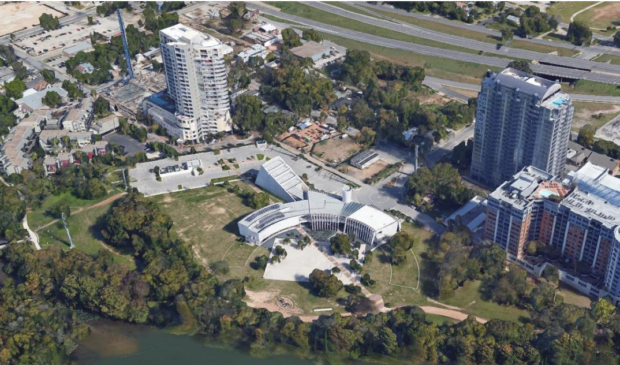Boulevard eyed as solution to Rainey Street traffic
Friday, July 7, 2017 by
Chad Swiatecki A major revamp of the Rainey Street neighborhood is one of the options in front of business and community leaders looking to solve an anticipated spike in traffic over the next decade.
Members of the advisory board for the Emma S. Barrientos Mexican American Cultural Center heard options Wednesday from a mobility study conducted by the Big Red Dog engineering firm, which completed the study commissioned by a developer planning to build in the popular district adjacent to I-35. The study, which was released last month, found that the nearly 30,000 daily car trips on Rainey Street could triple or quadruple if every development currently in the planning phase for the area becomes a reality.
The neighborhood’s traffic problems stem from the fact that Rainey Street is the only north-south path through the entire area, giving cars no other options for ingress and egress from what was originally constructed as a single-family housing district.
A possible solution offered by political consultant Jay Blazek Crossley, who contributed to the Big Red Dog study, would be to convert Red River Street to a “great streets”-style boulevard and connect it to River Street using property that has been planned for the MACC’s eventual expansion. The “second snake option” would potentially feed traffic onto Holly Street east of I-35, providing a second major path in and out of the popular nightlife area that sees major traffic spikes on weekend evenings.
Rather than blocking Rainey Street off from through traffic, which Crossley said would be difficult because of the neighborhood’s growing residential population, the great street proposal would address congestion by reconnecting the area to roads better suited for large traffic volumes and open the area up for mass transit. He said a layout with wide sidewalks similar to the Second Street district – and with two traffic lanes large enough for buses and trucks – would make Rainey Street into a more pedestrian-friendly area while showcasing the MACC.
Crossley told the board that the second snake option is one of the more unorthodox solutions for the district’s traffic woes and that the possibility of extending the great streets layout north on Red River to the University of Texas campus – tying it into the Waller Creek Conservancy – and continuing on Holly Street to its eastern terminus could create more support for the concept.
The study projects that at least $9.5 million from developer fees could be available to the area for mobility improvements, and Crossley advised the board to begin reaching out to city officials about possible plans for how to best use that money to ease congestion. He also said that the creation of a parking benefits district – like the one in the West Campus area – would redirect more parking meter revenue into the area to fund improvements to sidewalks and other infrastructure.
The presence of the MACC also creates the possibility of tourism-related funding from the city’s Hotel Occupancy Tax being available for improvements in the district.
“This area is cut off on all sides, and right now it’s difficult to make it more accessible to everyone,” Crossley said. “Smarter parking could benefit the neighborhood, and the MACC needs to come back to the neighborhood.”
Related to the center’s expansion plans, the board also heard a progress report on recent public forums that gathered input on what residents want from the facility that will celebrate its 10th anniversary in the fall. Initial drawings for the expansion are expected to be complete in the fall, and the master plan will be complete in early 2018. There is no firm plan for how to raise funds to expand the center, which was initially paid for through a bond issue.
Photo courtesy of the Parks and Recreation Department.
The Austin Monitor’s work is made possible by donations from the community. Though our reporting covers donors from time to time, we are careful to keep business and editorial efforts separate while maintaining transparency. A complete list of donors is available here, and our code of ethics is explained here.
You're a community leader
And we’re honored you look to us for serious, in-depth news. You know a strong community needs local and dedicated watchdog reporting. We’re here for you and that won’t change. Now will you take the powerful next step and support our nonprofit news organization?







